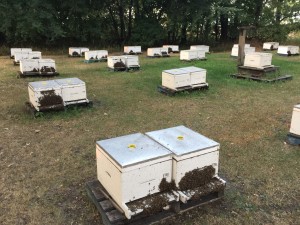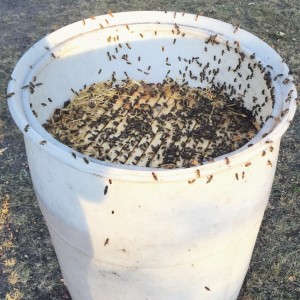Winter Prep

Winter preparation is all about preparing your bees for next spring and it begins as soon as honey flow is over. To increase your potential for next year, you can’t skip or cheap out.
Here is a quick rundown of how we prep hives for winter. The first thing to note is that if you have a failing queen or hive at this point of the season, it’s usually too late to do much about it. You can requeen into late august, but a hive without brood at this point will likely not make it through the winter. You can add brood frames to the hive from other more productive hives but I don’t take more than a frame per hive to boost another hive. Replacing queens during honey flow works best and younger queens are better and more vigorous than older queens. Some beekeepers replace up to 40% each year.
If you have mite issues, they have to be dealt with as soon as possible. Most beekeepers use oxalic acide with broodless hives. We have had good success with MAQS pads from NOD Apiary Products. We use a half dose (one pad) per hive. We also used it on our 6 frame nucs and it seems to work well.
After all the honey is taken off the hives and our hives are down to single brood chamber, it’s feeding time. I usually feed within a week or two of taking off honey. Productive queens could have filled frames with brood and they could be starving if left without food for too long. Every hive gets about 25 liters of sucrose syrup. I have also used fructose for feed and have not seen any difference when using it.

Here are the two methods of feeding we use.
- Inverted pail method: This is probably the most used method by many beekeepers because you know exactly how much feed is going into the hive. It also works well in all-weather types and bees don’t need to leave the hive to get feed. It does however require a lot of manual labour to carry pails, invert them and refill as necessary. We use 2.5 gallon pails to feed with a 2 inch mesh. In spring, we use 1 gallon pails and feed about 2 quarts per hive using this method. One risk associated with this method is leaky pails that can flood a hive and kill most of the bees inside.
- Rob feeding: This is a method used by many commercial beekeepers because it’s less labor intensive and you can feed many hives at once. It involves filling barrels with feed, adding a floating device and have bees rob them out. The advantages are less labor and it’s a quick feeding method. For this reason, this has become our main feeding method for fall feeding. The disadvantages are that it’s weather depending and bees can transmit mites by the communal nature of feeding. If you’re planning on using this method, you also cannot be within 3 miles of another beekeeper.
We may also feed pollen patties in the fall just to give bees an extra bit of pollen coming into winter. We have had success without feeding pollen but a little extra can’t hurt right?
September 6, 2020 @ 12:32 pm
1. How do you make fall nuc boxes? Do you need a queen in fall? Or will they make their own queen?
2. We have moved from a double brood box to a single for the winter. We find a lot of the bees aren’t going back into the box. Is this a problem? Is there a solution?
September 7, 2020 @ 4:18 pm
I do not make nucs in the fall. I make them in July-early august at the latest so they have time to establish themselves. After mid August, I would not allow them to make their own queen because you loose too much time. They would require a mated queen that is ready to lay eggs to establish lots of young bees that will carry your nuc through the winter.
As for your second question, no that is normal. There isn’t enough space in the single hive for all the bees. Older bees will eventually die off and that should leave you with your young bees in the hive. Every fall when I take off the last honey supers, I have the same result.